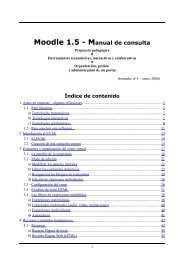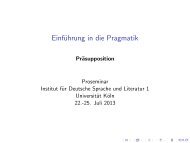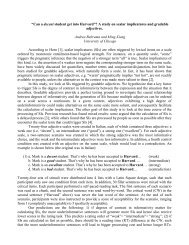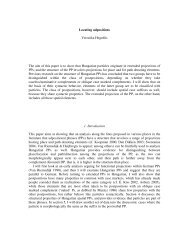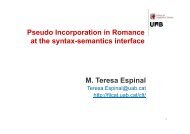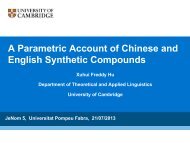Semantic aspects of differential object marking - corpora@parles.upf ...
Semantic aspects of differential object marking - corpora@parles.upf ...
Semantic aspects of differential object marking - corpora@parles.upf ...
Create successful ePaper yourself
Turn your PDF publications into a flip-book with our unique Google optimized e-Paper software.
<strong>Semantic</strong> <strong>aspects</strong> <strong>of</strong> <strong>differential</strong> <strong>object</strong> <strong>marking</strong> 7<br />
shows that a definite reading is perfectly possible without the occurrence <strong>of</strong> overt case <strong>marking</strong><br />
in this way providing counterevidence to an analysis in which the occurrence <strong>of</strong> the case marker<br />
is triggered by the definiteness <strong>of</strong> the <strong>object</strong>. In order to establish that the occurrence <strong>of</strong> ko is<br />
not prohibited by the fact that it has already occurred on the indirect <strong>object</strong>, which could be<br />
argued in order to save an analysis in which definiteness triggers case <strong>marking</strong>, we include the<br />
following example:<br />
HINDI (Indo-Aryan; Bhatt and Anagnostopoulou 1996:13)<br />
(19) Ram-ne chitthii-ko Anita-ko bhej-aa<br />
Ram-ERG letter-KO Anita-DAT send-PERF<br />
‘Ram send the letter to Anita.’<br />
In (19), the case marker ko appears on the direct <strong>object</strong> ‘letter’ independent <strong>of</strong> the fact that it<br />
already occurs on the indirect <strong>object</strong>. Thus if definiteness really triggers the occurrence <strong>of</strong> ko,<br />
we would have expected it to occur in (18) as well, as its use is not ruled out on other grounds. 5<br />
Definiteness plays a role in <strong>differential</strong> <strong>object</strong> <strong>marking</strong> in Hindi but so far we have established<br />
that it is not responsible for the occurrence <strong>of</strong> the <strong>object</strong> marker. The other possibility is that<br />
the use <strong>of</strong> the case marker results in a definite interpretation. This is in correspondence with the<br />
conclusion reached in Butt (1993) who argues that ko is a marker <strong>of</strong> specificity. The fact that<br />
ko-marked <strong>object</strong>s have to be interpreted as definite was already established in example (14)<br />
and is also demonstrated in (20). The direct <strong>object</strong> ‘chicken’ in (20) has to be interpreted as definite<br />
(specific in Butt’s terminology) and as such it is infelicitous in the indefinite/non-specific<br />
requiring context in (16).<br />
HINDI (Indo-Aryan; Butt 1993:91)<br />
(20) xansaame-ne bazaar=se murvii-ko xariid-aa<br />
cook-ERG market=FROM chicken-KO buy-PERF<br />
‘The cook bought a particular/the chicken from the market.’<br />
The characterization <strong>of</strong> ko as a definiteness/specificity marker (as argued for in Butt 1993) does<br />
not hold across-the-board, but only within the domain <strong>of</strong> non-human <strong>object</strong>s. This brings us<br />
to the first claim we made above with respect to the table in (15). If we were to characterize<br />
ko as a definiteness/specificity marker we would leave unexplained the fact that the occurrence<br />
<strong>of</strong> this marker on a human direct <strong>object</strong> can result in both a definite and an indefinite reading,<br />
cf. (11) above. In our understanding the absence <strong>of</strong> an unambiguous reading for ko-marked<br />
human direct <strong>object</strong>s is due to the fact that the case <strong>marking</strong> with these <strong>object</strong>s is required by<br />
the animacy feature <strong>of</strong> the <strong>object</strong>. Human direct <strong>object</strong>s require overt <strong>marking</strong> with ko, i.e.,<br />
high animacy triggers the accusative case <strong>marking</strong>, and therefore this case marker can no longer<br />
trigger an alternation in definiteness. This is in contrast to less animate nouns where the case<br />
alternation clearly influences definiteness. In other words, the <strong>marking</strong> <strong>of</strong> direct <strong>object</strong>s with ko<br />
due to animacy takes priority over the function <strong>of</strong> ko as a definiteness marker. Only in contexts<br />
in which the case marker is not required by the animacy <strong>of</strong> the direct <strong>object</strong> can it be used to<br />
encode definiteness.<br />
Evidence for the claim that animacy takes priority over definiteness in <strong>differential</strong> <strong>object</strong> <strong>marking</strong><br />
can also be found in Kannada, a Dravidian language with a <strong>differential</strong> <strong>object</strong> <strong>marking</strong> sys-<br />
5 The double occurrence <strong>of</strong> ko does have repercussions for the possible word orders. In case both the direct and<br />
indirect <strong>object</strong> are marked with this case marker the direct <strong>object</strong> has to precede the indirect <strong>object</strong> (cf. Bhatt and<br />
Anagnostopoulou 1996).<br />
604<br />
7




